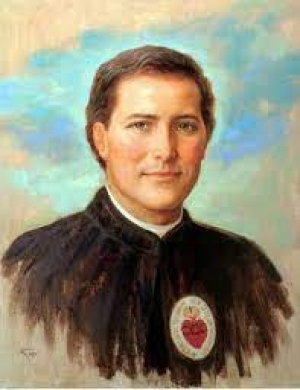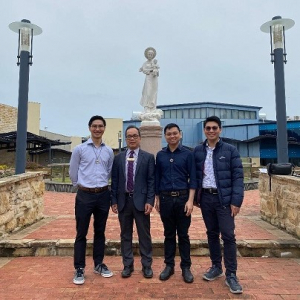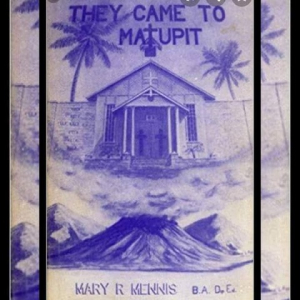Peter MALONE
Stranger, The/ 2022
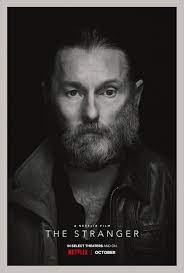
THE STRANGER
Australia, 2022, 117 minutes, Colour.
Joel Edgerton, Sean Harris, Matthew Sunderland, Ewen Leslie, Jade Alberts, Steve Mouzakis, Fletcher Humphreys, Alan Dukes, Gary Waddell.
Directed by Thomas M.Wright.
Recommendation: if possible, see this film, disturbing film, before reading any descriptions and reviews.
So, continuing for those who wish to read a review…
The Stranger informs us that it is based on actual events and characters. Which raises the difficulty, seen recently with the making of and release of Nitram, the story of the mass killer at Port Arthur, Tasmania in the 1990s and many considering it inappropriate to make a film of these events, condemning the film as exploitation. However, the writer and director of Nitram were very careful to focus on the central character and not to visualise his malevolent killings. And, it is the same here. This film is based on the abduction of Daniel Morecambe in Queensland. However, he is never named, and there is no re-enactment of his death. The focus is on the abductor and the criminal investigation.
And, the investigation is, in itself, quite extraordinary, the main action taking place eight years after the abduction.
A scruffy character boards a bus, sitting next to a friendly man who begins conversation. At their destination, the scruffy character helps out the man who wants to hire a car – and who then suggests that he could get a job for him, a mysteriously shady job, implications of drugs and smuggling, and he introduces him to a group of criminals. His friend from the bus is then ousted from the gang and the scruffy man, Henry Teague, is connected with another criminal, Mark. And, rightly, we wonder where this is going.
And, it should be stressed, this is a very atmospheric film, a lot of it in the dark, suggestions of the sinister, and a recurring image of a close-up of a vast mountain, and the camera moving over the forest trees. It is not a straightforward drama, but rather, for the audience, an evocative and provocative experience. This is to the credit of the writer-director, Thomas M. Wright, who has had an acting career but also directed another film about crime and obsession, Acute Misfortune.
But, very early in the drama, it is revealed that Mark is an undercover police officer and that the whole experience with Henry Teague is a sting, the drug issue a police set up, involving a team of undercover police. In the meantime, there is continued reference to two police officers from Queensland who are investigating the case, have Henry as their main suspect, but he has alibis and explanations which they have to test.
The film reminds us of the enormous stress placed on any undercover officer, keeping consistent with the scenario, continually watching oneself, careful, and the psychological pressure. This is very true for Mark, frequent comments through the film about breathing in and breathing out all the blackness. And, for some humanity, we see him with his young son, a cheeky boy, whom he cares for at times in shared custody.
On the one hand, the playing out of the scenario is intriguing, the ability of the undercover agents to keep Henry involved, but ultimately playing him, demanding that for this kind of work he needs to tell the truth – which leads to a confession, filmed, but which some of the legal officers saying it is inadmissible.
Ultimately, Henry is persuaded to revisit the scene of the crime (with a group pretending that they are experts in crime scene cleansing). But, there is the long and painstaking search for evidence in an area which has been flooded over the years.
This is an excellent dramatic film, with top performances by British actor Sean Harris (an eccentric Thomas in the 1999 Jesus to appearances in Mission Impossible actioners) as Henry and veteran Australian and international actor, Joel Edgerton as Mark.
- Based on actual events? Police investigation, scenario and undercover police work, working with the suspect, eventually getting a confession?
- The style of the film, the style of the photography, brooding, often dark, realistic but also evocative? Editing and pace? Symbolic images, especially the mountain and the trees, recurring?
- The time sequences, the investigation eight years after the crime, the range of flashbacks? The final reconstruction of the crime?
- The introduction to Henry, bearded, quiet, the touch of the sinister, in the bus, sitting next to Paul, Paul making conversation, in replying, friendly, the issue of the car, Henry giving his postal address to guarantee the car? The meetings, the crime bosses, their getting rid of Paul, the passport, travel out of the country? The acceptance of Henry, his accepting of the group?
- The introduction of Mark, contact with Henry, the meetings, the conversation, appearances, giving Henry money to buy new clothes, his smartening up? The introduction to the other bosses, the meetings, the jobs, transferring of goods, Henry as a courier, Mark as his guard? The success of the arrangements?
- The audience surprise with Mark, the communication with the police, his identity, undercover? Interest in him, audience sympathy? The sequences with his son, the son being cheeky, the baths, the hiding game, out in the street? Mark and custody, the separation from his wife?
- The background of the police investigation, Detective Rylett, her background, her associate, their files, the details of the investigation, frustrations? The film returning to them in their growing involvement in the police scam and the detection? Their information about the crime, the reconstruction, the cars, the timing, the alibi, the underpass, the boy’s disappearance? The determination that Henry was the abductor?
- The continued friendship between Henry and Mark, the scenes for the stress on Mark, talking with the authorities, the therapy issues, his denials? Visiting Henry’s house, enjoying the company?They aredriving together?
- The various interviews, especially with John, as the head, the interview with Henry, demanding the truth, Henry admitting that his real name was Peter Morley, his time in prison in the Northern Territory, explanations?
- The set up for the job in Melbourne, the flight, interview with John, the meal in the restaurant, the package, the return? Payment?
- Mark and the scene with John and the police, the jokes, Mark serious, the film providing the background for this kind of police scenario, scam, the invention, the setup of a criminal gang, yet Henry not really knowing much about it? But believing?
- John and his stern interviews with Henry, Henry telling the truth about himself?
- The plan to get the truth from Henry, Paul and his interrogations, pretending to be the cleaner of the crime sites, getting all the details, their eventually visiting the site, Henry wanting Mark to be there?
- Henry, the underpass, his explanations, his alibi, the old woman, detective Rylett and the interviews, getting the information of whether the old woman was at the RSL club or not, breaking Henry’s alibi? Out into the bush, Henry the explanation, the flooding of the area, the evidence gone? Paul and his question about how Henry killed the boy, demonstrating on Mark? Henry’s confidence in opening up completely?
- The police, the plan, the footage, filming the interview with Henry, the police chief and his scepticism, that this was all inadmissible evidence? The responsibility in Queensland, finally accepting of the evidence?
- Henry, the police converging on him, arresting him?
- The many people involved in the search, combing the area, the hand up if anything was found? The man putting his hand up?
- The aftermath, the motif throughout with Mark talking about breathing in, breathing out of the blackness, telling this to his son, his final comments in the film?
- The successful picture of a police investigation, the setting up of the scenario, undercover agents, their skills? The confession?
Some Significant October Days for the Chevalier Family. 2022
Some Significant October Days for the Chevalier Family. 2022
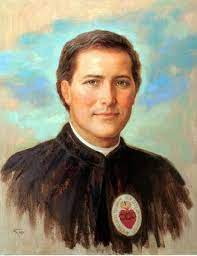
Many of the significant October days are part of the life of Jules Chevalier, not only the anniversary of his death, October 21st but other days: his vision of the role of the laity in the MSC, his resignation, his anointing.
1 October, 1905
The MSC Generalate transfers from Belgium to Rome, Piazza Navona, the site of the first MSC house in Rome. No longer the Generalate, but the Church and Shrine of Our Lady of the Sacred Heart, Piazza Navona, continues to draw pilgrims from all over the world and continues to be served by the MSC today.
2 October, 1901
The MSC Generalate, expelled from France, is established at Remy-lez-Chimay in Belgium.
3 October, 1901
Father Founder resigns as Superior General. French MSC, Father Arthur Lanctin succeeds him as General (1901-1905). Father Lanctin is also buried in the Crypt in Issoudun.
3 October, 1918
Death of Father Emile Maugenest, O.P., co-founder of the MSC Society. Maugenest had been compelled to leave Issoudun and the MSC's in 1857 in obedience to the Cardinal Dupont, Archbishop of Bourges who appointed him as Archpriest of Bourges Cathedral. He later entered the Dominicans, but remained on good terms with the MSC and
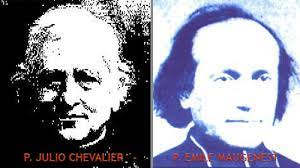
was at Father Chevalier's side in 1904 for the celebration of the 50th anniversary of the MSC Society.
4 October, 1904
The old Third Order becomes "The Society of Souls Consecrated to the Cult of the Sacred Heart of Jesus", a title suggested by Rome. Chevalier had envisioned this branch, not so much as a work of the MSC's, but as an extension of it into the laity. However, this original vision was lost when the MSC General Chapters of 1905 and 1907 rewrote the 1877 Constitutions. The re-written text gave the impression that the MSC Society consisted solely of religious priests and brothers.
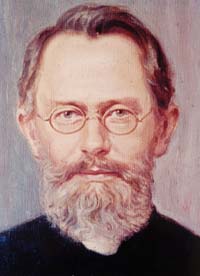
5 October, 1922
Father Hubert Linckens, MSC, first Provincial Superior of Germany (1897-1910) and historical founder of the MSC Sisters, dies in Hiltrup, Germany. Linckens guided the MSC Sisters until 1911 at which time he became the first General Assistant of the MSC in Rome, and in this capacity lived in Australia from 1914-1920. Because World War I, he couldn't return to Italy and therefore stayed in Australia, during which time he helped in the up-building and promotion of the Australian MSC Province.
9 October, 1907
Fr. Chevalier receives the Anointing of the Sick, administered by Fr. Hériault in the presence of his confreres, some FDNSC Sisters and M. Bernard de Bonneval, in whose home he was living after having been expulsed from his presbytery in January of the same year.
10 October, 1867
Inauguration of the Apostolic School at Chezal-Benoît.
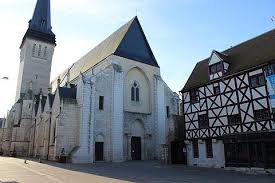
11 October, 1953
For the first time since the death of Fr. Founder, an MSC parish priest is installed in the parish of Saint Cyr, Issoudun. The parish priest of Saint Cyr continued to be an MSC until 2010 when it was again handed over to the diocese. However, today there remains an MSC presence with Vicars Fathers Joseph Desbois (Fr) and Lazare Elenge (DRC).
14 October, 1853
Father Jules Chevalier is transferred as curate from Châtillon-sur- Indre to his third parish, Aubigny-sur-Nère. The following year, on 21 October, 1854, he would go to Issoudun and remain there until his death, exactly 53 years later to the day.
15 October, 1906
Because of the expulsions, Father Chevalier authorizes the transfer of the FDNSC Generalate and novitiate to Thuin, Belgium.
17 October, 1872
Consecration of France to Our Lady of the Sacred Heart.
17 October, 1884
Departure of the first five FDNSC from Issoudun to the mission of Melanesia.

21 October, 1907
Death of Father Chevalier, founder of the MSC, the FDNSC and spiritual founder of the MSC Sisters. He is buried in the Crypt in the Basilica on the 24 October, 1907.
27 October, 1913
Monsignor Couppé founds the Congregation of the Daughters of Mary Immaculate (the FMI Sisters) the first local Congregation of Sisters founded in PNG.
Their formation is entrusted to the FDNSC Sisters.
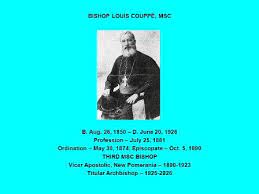
Tim Brennan MSC, new Vatican appointment.
Tim Brennan MSC, new Vatican appointment.

Congratulations to Tim whose present ministry is Profession Standards for the whole congregation. Any spare moments have now been taken by the Vatican.
Pope Francis on Friday appointed 10 new members to the Pontifical Commission for the Protection of Minors.
The Holy See Press Office said the Pope has appointed as Members of the Commission: Bishop Peter Karam, Bishop Thibault Verny, Fr. Tim Brennan, MSC, Sister Mary Niluka Perera, RGS, Sister Annah Nyadombo, HLMC, Dr. Irma Patricia Espinosa Hernández, Ms. Maud de Boer-Buquicchio, Dr. Anne-Marie Emilie Rivet-Duval, Ms. Teresa Devlin, and Ewa Kusz.

Cardinal Sean O’Malley OFMCap comments:
“They have all spent significant amounts of their professional lives listening to and supporting victim/survivors of sexual abuse by clergy and church personnel,” he said.
The commission’s 20 members include 10 women and 10 men. Twelve of the members are laypeople, three are women religious, three are bishops and two are priests. Four represent Africa or the Middle East, five come from the Americas, five from Asia and Oceania, and six from Europe.

For more information about the members:
ROME — Pope Francis reconfirmed the leadership of the Pontifical Commission for the Protection of Minors and expanded its membership from 17 to 20 people, naming 10 new members and reappointing 10 returning members.
U.S. Cardinal Seán P. O’Malley of Boston, president of the commission, said, “Coming from all over the world with varied backgrounds and a common passion for the well-being of children and vulnerable people, the members announced today include advocates and practitioners of prevention and protection to the many areas in which the church ministers to children.”
The members include “representatives from canon law, social work, the medical and psychological professions, law enforcement and the judiciary as well as pastoral experts who currently work in dioceses and religious congregations,” he said in a statement Sept. 30, the day the appointments were announced.
“They have all spent significant amounts of their professional lives listening to and supporting victim/survivors of sexual abuse by clergy and church personnel,” he said.
The commission’s 20 members include 10 women and 10 men. Twelve of the members are laypeople, three are women religious, three are bishops and two are priests. Four represent Africa or the Middle East, five come from the Americas, five from Asia and Oceania, and six from Europe.
The commission’s leadership continues to be Cardinal O’Malley as president and Oblate Father Andrew Small as secretary “pro tempore.”
The new members are:
— Sacred Heart Missionary Father Tim Brennan, a canon lawyer from Australia.
— Maud de Boer-Buquicchio, a lawyer from the Netherlands, long active in serving at the European Commission of Human Rights and its court and the Council of Europe. She was the U.N. special rapporteur on the sale and sexual exploitation of children from 2014 to 2020.
— Teresa Devlin, an expert in child protection from Ireland, currently serving as CEO of the National Board for Safeguarding Children in the Catholic Church in Ireland.
— Emilie Rivet-Duval, a clinical psychologist from Mauritius specializing in the mental health of young people.
— Irma Patricia Espinosa Hernández, a surgeon, theologian, psychiatrist and psychotherapist from Mexico specializing in criminal psychology and the profiling and evaluation of victims of abuse and sex offenders.
— Maronite Bishop Peter Karam, a Lebanese who serves as patriarchal vicar of the Maronite Synod of Bishops.
— Ewa Kusz, a psychologist, therapist and forensic expert from Poland, who organizes conferences, studies and formation seminars for the church on safeguarding.
— Sister Annah Theresa Nyadombo, a member of the Handmaids of Our Lady of Mount Carmel, she is coordinator in Zimbabwe of Talitha Kum — the global network of religious helping survivors of human trafficking — and is the coordinator of education and safeguarding for the Zimbabwe Catholic Bishops’ Conference.
— Sri Lankan Good Shepherd Sister Niluka Perera, a social worker and coordinator of Catholic Care for Children, a project of the International Union of Superiors General in Rome. She is also active with anti-trafficking networks, including Talitha Kum.
— Auxiliary Bishop Thibault Verny of Paris, who heads the archdiocese’s efforts in child protection and is chairman of the Safeguarding Commission of the French bishops’ conference.
The returning members are:
— Auxiliary Bishop Luis Manuel Alí Herrera of Bogotá, Colombia, a psychologist and theologian.
— Ernesto Caffo, founder and president of an Italian non-profit promoting children’s rights and combating abuse and violence against minors.
— Indian Sister Arina Gonsalves, an expert in law and education, vice provincial of the Religious of Jesus and Mary, and secretary-general of the safeguarding center for the Latin-rite bishops’ conference of India.
— Nelson Giovanelli Dos Santos, the Brazilian co-founder of Fazenda da Esperança and an expert in the rehabilitation of young victims of drug addiction and abuse.
— Sinalelea Fe’ao, chief education officer for the Diocese of Tonga and Niue.
— Teresa Kettelkamp, former executive director of the U.S. bishops’ Secretariat of Child and Youth Protection.
— Benyam Dawit Mezmur, an Ethiopian professor of law specializing in human rights and children’s rights. He was chairperson of the U.N. Committee on the Rights of the Child in 2015-17.
— Neville Owen, a retired senior judge and former chair of the Australian Catholic Church’s Truth, Justice and Healing Council.
— Jesuit Father Hans Zollner, president of the Pontifical Gregorian University’s Institute of Anthropology and Interdisciplinary Studies on Human Dignity and Care, which trains experts in safeguarding and in the care of survivors.
— Juan Carlos Cruz, a Chilean communications executive, abuse survivor and advocate supporting survivors and preventing abuse.
Pope Francis formally established the pontifical commission in March 2014. The body of experts, with input from survivors, is meant to make proposals and spearhead initiatives to improve safeguarding norms and procedures. It remains an advisory body for the pope, and it offers concrete assistance to every level of the church worldwide.
Thoi Tran MSC - farewell from Vietnam, welcome to Coogee
Thoi Tran MSC - farewell from Vietnam, welcome to Coogee

This post honours Thoi Tran who went to Vietnam with Peter Huan MSC almost 20 years ago to establish the MSC presence. Last month, he left Vietnam, returning to Australia, appointed to Coogee parish where two weeks ago he was installed as parish priest.
Bob Irwin, Provincial Superior at the time of the 2003 foundation writes:
THANK YOU, THANK YOU UNCLE THOI
After successfully battling two long bouts with cancer, Thoi returned to his homeland in August to spend a few weeks with his mother, family members and friends, before flying to Sydney to take up his new ministry as parish priest of Coogee.
On the morning of 10 September, the Vietnam MSC community gathered to try their best to show Thoi how much he is appreciated and loved here in Vietnam.
There was, of course, a strong sense of sadness at his departure, but the overarching feeling was one of tremendous gratitude to him for all that he has been for the community and what he has done for us over the past nearly twenty years.
Thoi’s life has been one of great challenge and generosity. Born in Vietnam, joining a minor seminary here as a young man, then a refugee to Australia, then joined the MSC in Australia, then ordained at St Brigid’s church, Coogee, in September 1995.

1999 was a crucial year for MSC Vietnam. This was the year when we made a very touching and important step in our movement towards coming to Vietnam. The famous “meeting” mainly centred on whether or not these two fine men were prepared to go back “home” and leave their ministries and friends in Australia. Tears were shed, and thus began several years of investigation/research and discernment.
2003, Thoi moved back to Vietnam, and he and Peter shared the responsibility of a new beginning.
Thus, Thoi has been here since the beginning, and as the various speeches at his farewell made clear, his person, his example, his wisdom, his faith, his dedication, his generosity, his “MSC ness” as he held the roles of formator and/ or community leader, have all helped to form us into the community we are now.
Hoang, one of his first students in 2003 has been the community leader here now for some years, and the next generation of MSC whom Thoi helped form, now take on the formation of the next generation. Thus it is meant to be!
How the world turns: Ordained at Coogee this month, 27 years ago…installed as Coogee parish priest September, 2022.
Thanks, Thoi……Your Vietnamese MSC family pray that the good Lord continues to bless you and keep you close to His Heart.
And a baptism memory when Thoi ministered in Coogee some time ago.
Taste of Hunger/ Smagen af Sult
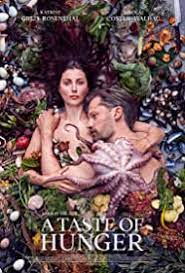
A TASTE OF HUNGER/ SMAGEN AF SULT
Denmark, 2021, 104 minutes, Colour.
Katrine Greif-Rosenthal, Nicolaj Coster-Waldau, Flora Augusta, Charlie Gustafsson, August Vinkel, Nicholas Bro.
Directed by Christoffer Boe.
With so many very popular cooking programs on television, programs from all over the world, chefs and bake-offs, it is not surprising that there have been quite a number of films in recent years taking audiences into kitchens, observing food preparation, observing cooking, observing service and style.
As the title seems to indicate, this is one of those films. It comes from Denmark and stars popular International Danish actor, Nikolai Costa-Waldau as Carsten, meticulous cook, a rather different role, from trekking across the Arctic to mythological adventures in Game of Thrones. And he is matched by Danish actress, Katrine Greif-Rosenthal, as his wife, Maggie.
For those who watch the film, there is quite an amount of food preparation, cooking, failures in the kitchen, eating – and, as it emerges, the desperate hope for the restaurant in Copenhagen to receive the honour of a Michelin star. And, it would seem that this is the greater hunger, the hunger of ambition dominating so much else.
The film creates the atmosphere of Copenhagen, of the restaurant, especially in the kitchen, as well as homes and apartments, other restaurants. And, there are some dramatic excursions to the countryside outside Copenhagen.
But, audience attention is more and more drawn to the relationship between Carsten and Maggie, their two children, life at home with Carsten’s preoccupation with his restaurant (his daughter complaining that he talks about food even away from the restaurant). Gradually, deeper tensions are revealed, a mysterious typed letter indicating that Maggie is not faithful to Carsten.
Audiences have to pay quite some attention to the chronology of the film – because, we realise, that it is presented as something of a jigsaw puzzle. On the one hand, there are the scenes in present Copenhagen, times indicated specifically at the bottom of the screen. Then, there are some words presented something like a screen poster, a heading, and some attention to detail and action. And we realise that we are being taken back into the past, sometimes within a few minutes of a present scene. Eventually, we are able to put all the pieces in place but it is a challenge to attention.
The main flashback is to the first meeting between Carsten and Maggie, his background, failure at a function, her coming to his support, inspiring him – and a realisation that they have been running the restaurant for 10 years, married for 10 years. In the background are quite a number of genial characters, especially Carsten’s older brother whom he worked for, another man who is his mentor, and a number of cooks, including Frederick, the younger member of the group.
There is also a frantic sequence when one of the children is lost in the forest, a desperate search. And there is also a highly dramatic sequence involving the young daughter, the repercussions of the tensions in her parents’ life becoming overwhelming.
Actually, we can leave the cinema in quite a cheerful mood in some respects – and, a note, there is actually another minute with Carsten and Maggie after the final credits.
- A cooking film? A marriage and parenting film? An ambition film? Combination?
- The Copenhagen setting, the restaurant, interiors, customers, the kitchen? Homes? Other restaurants? The streets? The woods, forests, the water? The musical score?
- The title, the focus on food and taste? An appetite for success? The Michelin star?
- The structure of the film: in the present, the style of noting Copenhagen and various times? The headings, the chapters, as flashbacks? The various pieces of the film and putting them together?
- The initial focus on Carsten, the restaurant, the kitchen, interaction with the staff, hard, demanding? The visitor rejecting the oysters? Confronting Frank and firing him? Hope for the Michelin star? The presence of Maggie at the restaurant? Encouragement and support? Finding the letter denouncing her?
- The flashback to beginnings, his story of working with his brother, the years in Japan, the ship giving him the knife and firing him? The return home? Setting up the restaurant? The catering, its failure, Maggie coming into the kitchen, support, the ingredients for hot dog? Their marriage? 10 years, the two children? Life at home?
- Maggie’s story, the initial encounter with Carsten, the marriage, the children, home life, the commitment to the restaurant, ambitions? Carsten away from home, Chloe commenting on his absence, his talking about food outside the restaurant? Maggie with the children, the clashes between the two, making each apologise, the mushroom sequence, Maggie on the phone, Chloe not paying attention, August and his disappearance? The search, Chloe and her resentment, going to the road, leaving the group the search, finding August to sleep? And his poking out his time at Chloe?
- Maggie, the relationship with Frederick, his restaurant work, contacts, information about the Michelin visitor? The flashbacks, seeing him with the family, extended family, with Maggie, the affair? Her thinking he wrote the letter? The blackmail, her leaving home, the sexual encounter, he forcing himself, the information about the visitor?
- The confrontation with Carsten, Chloe overhearing it, the harsh words, the truth, the past? Alienation? Two months later, separate, plan for the divorce? Call to the school, Chloe not doing well? Her going to the counselling session, her telling the story, admitting she wrote the letter, the Counsellor asking whether it be better for her parents to know, their offering to tell the parents?
- The announcement of the Michelln stars, everybody at the restaurant, Maggie, the children, the announcement, the failure to get the one star? The reaction of some of the cooks? The sudden news of the two stars? Carsten his speech, acknowledging Maggie and her story? And the post-credits scene of the two at the bar and the whiskey sour?
- The story of a marriage, ambitions, tensions, failure, forgiveness or not? The children?
- And also a film for food lovers, the attention to menus, cooking on details?
Secret of Chimneys, The
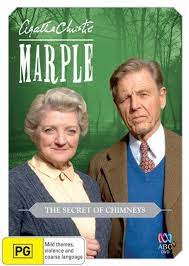
THE SECRET OF CHIMNEYS
UK, 2010, 90 minutes, Colour.
Julia McKenzie, Stephen Dillane, Edward Fox, Adam Godley, Charlotte Salt, Laura O'Toole, Matthew Horne, Jonas Armstrong, Michelle Collins, Anthony Higgins, Dervla Kirwan, Ruth Jones.
Directed by John Strickland.
The Secret of Chimneys is a comparatively early work by Agatha Christie, from 1925, with a 1920s setting, mansions in the country, activities and mining in Africa. And Miss Marple does not appear in the novel. In fact, the screenplay for this film does take some elements from the original story, making it recognisable enough, the changes characters, plot lines and developments, opening in 1932, the main part of the story in 1955.
It is clear that this is not a film version for absolute devotees of Agatha Christie’s writings. For those not familiar with the novel, it comes across as an interesting murder mystery.
This is Julia McKenzie Miss Marple, her becoming very much involved with the investigation, alongside the Inspector from Scotland Yard, played by Stephen Dillane. As with all these films, there are quite a number of British character actors in supporting roles, led by Edward Fox and Adam Godley, Anthony Higgins in older age, and Dervla Kirwan.
The film has an exotic touch with the visitor from Germany wanting to take possession of the mansion, Chimneys, owned by politician, Edward Fox. Adam Godley is his insistent assistant, has proposed to his daughter. But, there is also some romantic background, the main suspect in love with the daughter.
As the film goes through, the Inspector and Miss Marple develop quite a number of theories as to what happened. However, it is Miss Marple who gathers everyone together and reveals the truth.
- The popularity of Agatha Christie mysteries? Of Miss Marple? Of the three actresses as Miss Marple?
- The original novel and the screenplay incorporating elements but very different from the novel?
- The opening, 1932, the lavish setting of Chimneys, the celebration, Agnes and dancing to the music, the silhouette on the wall, the person approaching, Agnes warning against it, her being killed?
- The move to the mid-1950s, British politics, connection with Germany and industry, contracts, iron? The letter from the count, Clement and his response, Lomax and his urging? Eversleigh and his subordinate role? Chimneys in a state of disrepair? Yet the agreement to have the party?
- The family, Virginia, Lomax and his proposal and insistence, Bundle the older sister, practical? Treadwell, her having been in service since the 1930s? The arrival of Miss Blenkinsop, wanting the building to go to the National Trust?
- Virginia and the episode of the assault, Anthony coming on his bicycle, the rescue, the attraction, the later meetings? The revelation about his background, Africa, his partner, the blackmail, the recovery of the diamond? Eversleigh and his gambling, payments by Anthony? His concur in with the bicycle incident? His typing the letter to invite Anthony to come?
- The arrival of the count, European style, charm, the music, dancing with Virginia, the meals, the men and the arrangement for the signing over of the house? The count and his death, in the corridor, the gun? His last word wundt – indication of the wall?
- Miss Marple, friend to Virginia’s mother, her arrival, participating in the gathering?
- The night, hearing the shot, the banging, everybody assembling, the count not in his room, everybody searching? Finding him in the corridor?
- The calling in of Scotland Yard, Inspector Finch, his record, knowledge of Miss Marple, working with her, not wanting to be on her list of conquest and detection, his finally conceding, but having the diamond?
- The investigations, the interrogations? The discovery of Anthony in the tunnel, the gun, in custody? Virginia and her response? Accepting the proposal of Lomax?
- The various theories and hypotheses? The discovery that the count was in the orchestra in 1932, that he was having an affair, the assumption that it was with Agnes the maid, and her death, and the disappearance of the diamond? The musical score and its code, Bundle solving it? The count looking at the painting, the assumption of the connection between the painting and the diamond, and the secret door?
- The discussions with Treadwell, secrecy, indications of the past, her death?
- The coffin, opening it, the dust, Agnes and her apron, her bones? Confirming hypotheses? And further revelations from Miss Blenkinsop about Agnes in the past, Miss Blenkinsop and her causes, condemnation of the heartless aristocracy? Her being caught examining the past documents?
- Miss Marple, the note for Anthony, the typewriter, the letter not fully black? Eversleigh and his explanations?
- Anthony taken away, his escape from the car, the return, declaration to Virginia?
- Miss Marple, with Inspector Finch, the discussions, her awareness of the truth, everybody gathered together? Clement as the villain, his awareness of his wife’s relationship with the count, the count as a musician, Clement walking to trap them, killing Agnes, marrying her, putting the diamond in the coffin for blame, his retrieving it with the open coffin, concealing it in the pond? His awareness of the letters? But the continued correspondence, their being found, used? Clement and the reason for killing Treadwell but she was trying to protect Clement’s wife?
- The shock for Virginia, the message, the realisation that the count was her father, his visit, his death? And the message about Richmond, the roses, the Rose wall?
- Anthony, the vindication, happy ending, Miss Marple’s achievement?
Sissy/ 2022

SISSY
Australia, 2022, 102 minutes, Colour.
Aisha Dee, Hannah Barlow, Yerin Ha, Lucy Barrett, Daniel Monks, Emily De Margheriti.
Directed by Hannah Barlow, Kane Senes.
There are certain advantages for reviewers in not necessarily knowing anything in detail about the film they are to preview. Which means that they are in for many surprises. That does not happen for the popular audience because there are the trailers, the posters, talk about the film, meaning that the audience goes in ready and expecting.
So, for this reviewer, no previous knowledge. However, of course, the title Sissy (apart from reminding film buffs of the German 1950s series on the Empress Elizabeth, Sissy, screening often on SBS), the only other Sissy is Sissy Spacek – and that did come to mind later.
Which means for the first half of the film, everything seems nice, the introduction to two little girls, best friends for life, Sissy and Emma, filmed together in home movies, declaring their friendship, marrying their treasure trove in a secret place. And, scenes from these home movies will recur throughout the whole film.
It will depend on our attitudes towards personalities seeking fame and followers on social media as to our response to Sissy as she grows into a young woman. Not only does she have a program, exerting her absolute charm full-on on screen, seeing herself as something of a therapist for her followers, advocating various products, and delighting in the number of followers and online comments. To those wary of online gurus, she begins to seem a bit much. She is glamorous, has a pink rope she places around herself for boundaries, and is into affirmation that she is loved.
So, where is this going? In a major scene, it actually goes to the local supermarket, Sissy, now professionally calling herself Cecilia online, is careless of others, knocking twice into a pregnant woman without too much worry, but the main thing, seeing Emma whom she has not met for years, Emma not holding Sissy in her memories much is Sissy would like. But, Sissy accepts an invitation to a party (one of those eager, noisy, semi-dark, loud music, drugs and drink parties). And, discovering that Emma is in relationship with another woman (who turns out to be a genuine psychologist doing a doctorate).
So far, so non-horror that the poster and the trailers highlight! It is when Sissy agrees to go with Emma and her friend, and friends, for an outing to the home of another woman from school, Alex, the tensions arise, criticism from Emma’s friends (though Emma always defends Sissy) about her exploiting products and running the danger of harming viewers. And, Alex is particularly disagreeable. (And, for those becoming a bit impatient for the horror, now begins – and a flashback to explain Alex’s injuries and animosity!.)
It is then that the memory of Sissy Spacek comes to mind, especially for her early and groundbreaking role as the disturbed teenager, Carrie, and the vengeance she wreaks. Sissy gets involved in all kinds of situations, loses it, continues to lose it, and there are a couple of twists to surprise us.
Sissy is a survivor, and Cecilia continues her charm outreach to her followers. Would a sequel showing us Cecilia’s coping/not coping in the future be in order? (Sissy is played effectively by Aisha Dee, Emma by Hannah Barlow who plays Emma, wrote the screenplay and co-directs.)
- Portrait of Sissy? As a little girl, as a young adult, as a social media personality, narcissist, friendships, re-encountering Emma, and the consequences? Disintegration of a personality?
- Filming in Canberra, homes, but travelling to the country, the coastal highway, the bush, the home, scenery, water, cliffs? The police precinct? The musical score?
- Setting the tone, the home movie, Sissy and Emma, their age, friendship, chatting together, Best Friends in the locket, the burying of the memento box? The playing of the sequences right throughout the film? Part of Sissy’s consciousness – and Emma having forgotten? The further videos and memories, Sissy confronted by Alex, the taunts, Emma in the background, and, eventually, the audience seeing Sissy’s attack on Alex and the wound to her face?
- Sissy becoming Cecilia, her pod cast, her seeing herself as a therapist, the promotion of various goods, her charm, rapport with the audience, all the hits, all the comments? Sissy basking in the warm response? The number of followers? Her continually looking at her phone, reinforcing the response of her followers?
- The portrait of the personality on social media, doing good, but self-centred – and the awareness that Cecilia was more and more narcissistic (and one of the songs in the film, referring to Narcisa)?
- Sissy, biracial, no explanations, no family? Living alone? Confidence, lacking in confidence? Reaffirming herself, especially that she was loved? The pink rope and the circle and boundaries? Going to the supermarket, looking at the products, her carelessness with the pregnant woman, pregnant, almost hitting her with the car, and her really not caring?
- The encounter with Emma, initially avoiding it, at the checkout, Emma and her enthusiasm, their not having met for so many years, Emma persuading her to come to her party, Sissy deciding to go, the 20 somethings, the party, the rave, the enthusiasm, drink, drugs, Emma and her being stoned? The introduction to Tracy, Emma and Tracy as partners? Tracey’s background as a psychologist and doctoral student? The other friends, especially Fran and Jamie?
- The invitation to come to the holiday house, Sissy accepting, her motivation, wanting love and acceptance, driving there, the others as passengers, the scenic route, the house? And Alex emerging? The relationship between Emma and Alex? The public scorning of Sissy? The reconciliation, Alex offering a truce, for Sissy to sleep on the couch? The meal sequences, the conversation, criticisms of Sissy and her product promotion, Jamie and the risks should anything happen, putting Sissy on the defensive?
- Sissy and her dreams, mysterious characters, in the night, and dreaming of Alex?
- Going on the excursion, Emma leaving the map, Sissy hiding, overhearing the conversation, the criticisms and denunciations? The others going to the water? Alex calling out Sissy, the confrontation, memories of the injury to her face, the flashbacks and the graphic scene? Alex taking the phone, recording the confrontation with Sissy, the fight between the two, Sissy hitting Alex with the ice cubes, grabbing the phone, cancelling the scene? Her dragging Alex into the bush, burying her, the ritual covering?
- Jamie, his background, friends with the group, criticisms of Sissy, his crutches, falling, discovering Alex, hurrying away, the cliffs edge, the confrontation with Sissy, his falling over the cliff?
- Sissy returning the house, the confrontation with Fr, the attack, the bath, the blood, hiding her onto the bed?
- Driving away, Tracey hailing her down, the discussions between the two, speeding, sudden is stopping the car, the seatbelt, Tracy going through the windscreen, Sissy following her, crawling along the road, and driving over her?
- The return to the house, Emma turning up, Emma having slipped into the water and carried downstream? Talking with Sissy, Sissy dying her hair and trimming it, Alex, recovering, all discovering’s body, returning to the house, mesh Emma approached by mistake? Her shock?
- Contacting the police, the officer and his meat pie, the tracking device, his arriving at the house, seeing Alex confronting Sissy, shooting her?
- Sissy saved, the final scenes, her going onto her pod cast, the admiration, her glamorous look, her future, the violent narcissist?
Lou/ 2022
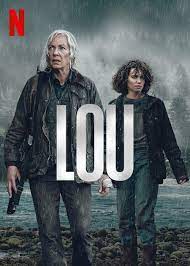
LOU
US, 2022, 107 minutes, Colour.
Alison Janney, Jurnee Smollett, Logan Marshall Green, Ridley Asher Bateman, Matt Craven.
Directed by Anna Foester
It had to happen. When we look back at the career of Liam Neeson in his late middle age (turned 70 in 2022), we remember that he made a new reputation for himself in starring in action films, on average, it would seem, one every year. The first that made an impact was Taken. And there were several sequels to Taken. So, it is surprising that it is only now that the producers have decided that they needed a female star as a variation on the Liam Neeson tradition.
And it is Alison Janney, who has won many awards over the decades, remembering her in The West Wing and her Oscar for hard mother in I, Tonya. And she is definitely a strong choice. She is a tall woman. She has no trouble in dominating the screen or in dominating other characters.
So, we are a bit surprised at the early part of the film when Lou seems to be in full depression, removing all her savings from the bank, wrapping packages of money, tossing documents into the fire, getting a rifle, ready to kill herself. We have already seen her clash with her neighbour, Hannah (Jurnee Smollett), almost knocking down her daughter with her car. So, where are we going?
Well, of course, what better than the screenplay that taps into familiar memories of action shows, the renegade father with a tough reputation (Green Beret, torturing prisoners, disappearing in an explosion, Logan Marshall Green) turning up and abducting his daughter.
Which means that off we go with Lou and Hannah, trekking through the mountainous and forest terrain of the islands off the Northwest coast of the US, discovering that Lou is not just some retired grandmother, but has a military, espionage background, action in Iran and the revolution, knows how to track, knows her bushcraft, is determined to recover the child. So, action, pursuit, hiding, some accidents… And Hannah rather puzzled at these revelations about Lou.
Not only does the film build up to the expected climax and confrontation, the screenplay surprises us, rather extraordinarily as we think back on it, with quite a dramatic twist.
For audiences who enjoy this kind of action show (usually with the male hero), then Alison Janney certainly impresses. And, despite what seems to happen in the finale, the filmmakers have given themselves an out for Lou 2.
- The title, the focus on Lou, as a person, her past, mistakes, possibility for atonement?
- The beautiful settings, the islands of the Northwest American coast, water, mountains, the town, homes? Trekking through the terrain? The musical score?
- The introduction to Lou, her age, grizzled, putting things in order, withdrawing money from the bank, the clash with Hannah, almost hitting Vee, demands for the rent? Packing the money, burning the documents and photos? Getting the rifle, to kill herself? Flashback indications about I ran, revolution?
- Hannah, pressures, money, love for her daughter, playing with her? Chris, his visit, memories of the past? His driving, giving them a lift, jovial, the music, Philip suddenly killing him, tying him up? Returning, abducting his daughter?
- The blackout, Hannah trying to fix it, her daughter’s disappearance, going to Lou, Lou about to kill herself? A reprieve?
- Introducing the sheriff, friendly, the metal band? Contacted later, the abduction, his contact with the authorities, CIA information?
- Action adventure, the storm, the dark, the mountains, the paths? The audience seeing Philip with his daughter, hiding, the carriage, the dolls, abandoning it? Their walking, arriving at the cave? The interactions at the K? Moving along to the lighthouse, on the top of the lighthouse, his reassuring her?
- Lou and Hannah, the tension between them, Hannah and her fears, Lou, the equipment, able to track in the dark, the weapons, the phone? Hannah and her trying to make contact with the sheriff? Discovering the house, the two men, Lou pretending that her dog was lost, hospitality, turning on them, the fights, killing them? Hannah’s reaction?
- Continuing on, the hardships, the dangers, the good and the footbridge, almost there, falling, losing an hour? Getting to the shore, Philip and the daughter absent? The fire at the lighthouse?
- Each of the women, their injuries, the first aid kit? Lou sending Hannah with the phone in the opposite direction? Her going to the lighthouse?
- The twist and the information, Lou and her background, Philip her son, Iran, letting him go, loyalty to the CIA? His own career, resentments, green beret, torturing enemy, his disappearing, presumed dead? Mother and son? His leaving the postcards challenging her? Her relationship to her granddaughter?
- The confrontation between mother and son, the fight, the axe, her shooting him? The basement, the daughter going to the toilet, hiding, her mother finding her, Lou enabling them to escape?
- Philip, wounds, pursuit, across the beach, Lou and her blowing up the lighthouse, the hovering helicopter? Eliminating CIA operatives? Mother and son fighting, the machine-gunning?
- The aftermath, the sheriff and the rescue, Hannah and her daughter, the bequest from Lou, packing to leave? The boat, and Lou watching through the binoculars?
MSC Vocation - Australian Province: Heading for Adelaide!!!
MSC Vocation - Australian Province: Heading for Adelaide!!!



29th September 2022 140th anniversary of MSC at Matupit Island, New Britain.
29th September 2022 140th anniversary of MSC at Matupit Island, New Britain.

Today marks 140 years when the first Missionaries of the Sacred Heart (MSC) landed on Matupit Island. Prayers for the Archdiocese of Rabaul.
On 29th September 1882 the first MSCs (Frs. Andrea Navarre, Theophil Cramaille and Br. Mesmin Fromm) arrived at Matupit Island after 13 months travel from Europe.

On arrival they learnt that Father Reńe Marie Lanuzel, a French diocesan priest had been there a year earlier. He came with the settlers on the Marquis de Rey expedition who settled at the south coast of New Ireland. When the scheme failed Fr.Lanuzel came and settled at Nodup under the care of ToLitur the local chief. He already began pastoral work in Nodup, Baai and Malagunan and baptized many children. When the MSCs arrived in Matupit, Fr.Lanuzel was away in Sydney to collect supplies for the mission.

The missionaries first settled in Nodup but due to geographical isolation they moved to Kokopo. Not long after they had to move again because their house was caught on a fire. They moved to Volavolo and there built the first church building.
